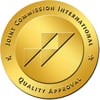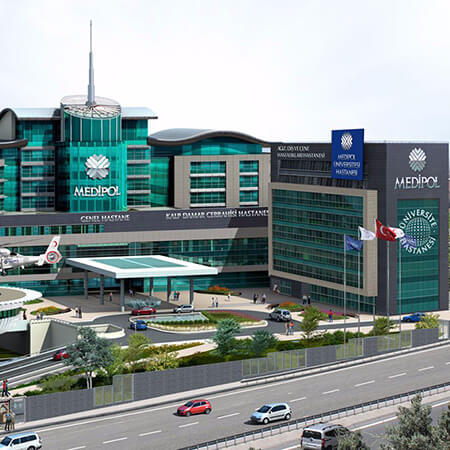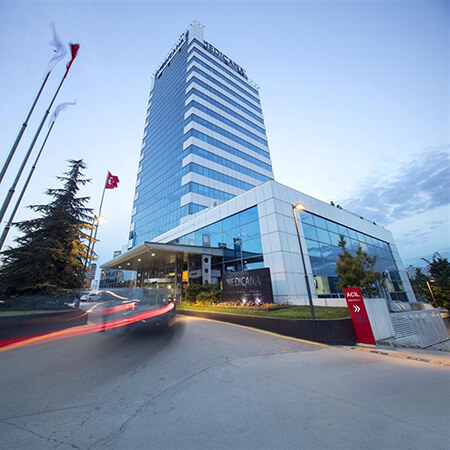To undergo treatment in Turkey, you just need to leave a request on Booking Health website.
Treatment of aortic coarctation in Turkey is very popular due to state-of-the-art equipment in clinics. Hospitals in Turkey are in high demand among foreign patients.
The cost of aortic coarctation treatment in Turkey may vary from clinic to clinic depending on the treatment method. Generally, prices for treatment start from 13,000(€).
You can find the list of the best clinics on the website and choose the one that suits you. For example, according to the clinics' rating, the first place is occupied by Medical Park Gebze Hospital.
Coarctation of the aorta is a congenital malformation of the cardiovascular system. Impaired hemodynamics develops as a result of narrowing of the aorta in various areas. This is often a severe pathology that requires surgery at an early age. However, in some cases, hemodynamic disturbances are not so significant – some patients undergo surgery at the age of 1-2 years, and in some patients coarctation of the aorta is diagnosed only in adulthood. To undergo treatment with the surgical method or minimally invasive procedures, you can go to Turkey. This country has one of the best price-quality ratio of medical services.
Peculiarities of the disease
Coarctation of the aorta is the third most common heart disease, and it takes second place among life-threatening malformations. The proportion of coarctation of the aorta in the structure of cardiovascular abnormalities reaches 10%. In men, the disease develops twice as often as in women.
There are different anatomical types of coarctation of the aorta, but one of them substantially prevails over the others. In 95% of cases, the narrowed area is localized at the site of the transition of the arch into the descending aorta, distal to the left subclavian artery. It has a length of 1-2 cm.
Coarctation of the aorta was first described 200 years ago. More than 100 years ago, the first anatomical classification was created. L. Bonnet has identified a child and adult type of the coarctation of the port. Later, these types began to be called differently, namely preductal and postductal forms. The history of surgical treatment for coarctation of the aorta dates back more than 70 years.
Symptoms
The pathognomonic (unique) sign of coarctation of the aorta is considered to be high blood pressure in the upper half of the body due to its decrease in the legs.
Here are some of the symptoms in children of the first year of life, which may be the reason for going to the hospital:
- Refusal of feeding
- Poor weight gain
- Shortness of breath during physical exertion
- Shortness of breath at rest
- Anxiety after feeding
Sometimes coarctation of the aorta has a mild course, and therefore manifests itself at the age of several years. The child has headaches, a sensation of pulsation in the head, fatigue during physical exertion. The pulsation in the femoral arteries is very weak or absent. After the age of 15 years, nosebleeds, pain in the heart, weakness in the legs and their cooling appear.
Diagnostics
The diagnostics of coarctation of the aorta requires the imaging of this vessel. The disease can be detected even in the prenatal period. A doctor can see a narrowed section of the aorta, and can determine an expansion area above it (closer to the heart).
Not all hospitals can diagnose heart defects during pregnancy, but after the birth of a baby the diagnostics becomes easier and more effective. Even in the absence of an apparent narrowing, indirect signs of coarctation of the aorta can be revealed:
- Dilatation of the cavity of the right ventricle
- Thickening of the wall of the right ventricle
- Dilatation of the pulmonary artery
- Increased index of the ratio of the cavity of the right ventricle to the left
- Increased index of the ratio of the pulmonary artery to the aorta
After the birth of the child, the functional load on the left ventricle increases. As a result, it becomes hypertrophied – a thickening of the wall of this chamber of the heart occurs. The total mass of the myocardium also increases, which is accompanied by its insufficient blood supply, because the vascular network develops more slowly. The expansion of the cavity and thickening of the wall of the left ventricle can be determined using ultrasound scanning from the age of 3-6 months. The more the aorta is narrowed, the more severe the hemodynamic disturbances are, and the faster the development of pathological changes in the myocardium occur.
Treatment of coarctation of the aorta
Coarctation of the aorta is the indication for the surgical treatment. If not operated, every third patient dies during the first year of life. The average life expectancy of patients with coarctation of the aorta in the natural course of the disease is 2 years.
Minimally invasive methods
In recent years, minimally invasive procedures have been used instead of surgery. They often provide similar results along with obvious advantages: lower risk of complications, absence of the significant injuries, lower prices, and absence of need for long-term recovery as after the surgery.
Here are the main minimally invasive procedures for correcting coarctation of the aorta:
Balloon angioplasty. Historically, this is the first minimally invasive method for treating coarctation of the aorta. A balloon is placed into the narrowed area of the vessel. This does not require opening the chest: a doctor makes a small incision in the leg and reaches the aorta through the blood vessels. After reaching the target region, the balloon is inflated. As a result, the narrowed section is expanded.
Disadvantages of the procedure:
- High relapse rate – up to 30% of patients require repeated minimally invasive procedures or operations in the future
- High risk of aortic aneurysm development
- The procedure is effective only with a small length of the stenotic area
Aortic stenting. This is a technique that is used in addition to balloon angioplasty. A doctor places a device, which keeps the vessel open, inside the vessel. As a result, the relapses of coarctation of the aorta are much less common. The procedure is effective even in case of a large extent of the narrowed zone.
In Turkish hospitals, doctors use modern stents, with adjustable sizes and reasonable prices. This is important given the continued growth of the child. Most patients are treated at the age of 1-2 years of their life. Before such stents have appeared, the procedure was only possible after reaching the age of ten.
In most hospitals, balloon angioplasty and stenting can only be used to treat coarctation of the aorta in young children, under 5 years. At this age aorta is elastic, so it can be stretched well. After the age of 5 years, the risk of aneurysm increases significantly. This is the most common and dangerous complication of balloon angioplasty.
Cardiovascular surgery techniques
In patients after the age of 5 years, as well as in cases that cannot be treated with minimally invasive procedures, cardiovascular surgery methods are used.
Aortic resection. The surgical procedure involves the removal of a part of the vessel in the narrowed area. The ends are sutured. This method of an anastomosis formation (vascular junction) is called "end-to-end". This operation is performed most often. It provides a low risk of recurrence of coarctation of the aorta even in the long-term perspective. However, such a surgical intervention is possible only in case of a small extent of the narrowed zone.
Resection with prosthetics. It is mostly performed in adult patients. Once the narrowed area has been removed, a vascular prosthesis is installed in its place. The surgical procedure is effective even with a large extent of narrowing.
Istmoplasty. This surgery aims to expand the narrowed section of the blood vessel. An incision is made on the aortic wall. The narrowed area is expanded using the patient’s own tissues or synthetic materials. If plastic repair involves the use of autologous tissues, then a flap from the subclavian artery is preferred. Usage of autologous tissues is often more favorable, as it excludes risk of the immune graft rejection.
Aortobifemoral bypass. This surgical procedure is rarely used. Its essence lies in the fact that a doctor forms a new path for blood flow, bypassing the narrowed section of the aorta.
Where to undergo treatment of coarctation of the aorta?
You can go to one of the Turkish hospitals. Aortic coarctation in Turkey is treated by experienced specialists in well-equipped Cardiovascular Surgery Centers. The main benefits of treatment in this country include:
- Highly accurate diagnostics, which allows to select the individual method of treatment of coarctation the aorta for each patient
- Low mortality rate – the risk of death does not exceed 1% in the best hospitals, which is quite impressive
- Affordable costs of treatment in Turkey with surgical interventions and endovascular procedures
- Possibility of treatment in two stages: in some patients doctors perform minimally invasive aortic expansion first, while the second stage involves the surgical treatment
- Experienced specialists who annually perform dozens of operations for coarctation of the aorta
- Well equipped hospitals, high level of medicine
- State-of-the-art surgical techniques providing long-term results, low risk of relapse and minimal invasiveness
Where to seek medical help from?
To undergo treatment of aortic coarctation in Turkey, you can use the services of Booking Health. With our service you can choose a hospital, compare costs of treatment in Turkey, get acquainted with the main medical programs. Booking Health can arrange your treatment in Turkey. We offer the following services and benefits:
- Selection of the best hospital for the treatment of aortic coarctation in Turkey, which doctors specialize in this disease
- Direct communication with the doctor of the hospital who will perform the operation
- Reduced waiting time for the treatment of aortic coarctation in Turkey
- Appointment for treatment in Turkey on the most suitable for you dates
- Reduced cost of treatment in Turkey – prices for surgery for coarctation of the aorta will be reduced due to avoiding additional coefficients for foreign patients
- Price control for the medical services provided by the hospital, return of unspent funds
- You will receive an insurance for up to 200 thousand euros, so the initial price of the program will not increase even in case of complications requiring additional treatment in Turkey
- Preparation of a treatment program in Turkey without the need to repeat previous diagnostic examinations
- Buying and forwarding necessary medicines
- Communication with the hospital after completing treatment of aortic coarctation in Turkey
- Organization of additional diagnostics, treatment in Turkey or rehabilitation after surgery
Booking Health specialists provide high quality services. We will book a hotel and airline tickets for you, meet you at the airport and take you to the hospital by car. During your stay in the Turkish hospital, you will be accompanied by a medical interpreter.








